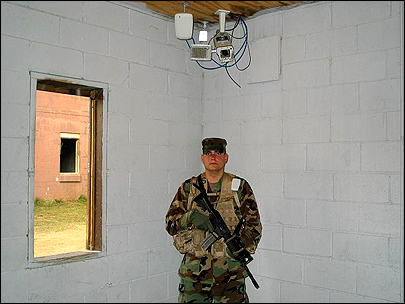At a Military Operations in Urban Terrain (MOUT) training site at Fort Benning, Ga., the U.S. Army is using an ultra-wideband (UWB) RFID system from Denver-based Ubisense to track soldiers engaged in a mock village comprised of a number of multi-floor, cinderblock buildings.
“Within a MOUT environment, we need to track the soldiers while they train, primarily for lessons learned and after-action review. So as the soldiers perform whatever mission they’re trying to accomplish, we are tracking their movements, their actions and their interactions with each other,” says Eric Wagner, director of DSCI, a systems integrator and software development firm. DSCI installed the UWB system and operates it on behalf of the Army.
Platoons of soldiers engage in combat training throughout the MOUT site, running drills of various operations, such as seizing buildings. As the soldiers move into and out of structures, they wear 900 MHz radios with GPS units, used to track their outdoor movements. They also wear Ubisense tags—Ubitags—so they can be tracked indoors. The 900 MHz radios then transmit the soldiers’ GPS coordinates to RF receivers installed throughout the MOUT site.
Multiple interrogators, called Ubisensors, are located throughout the buildings, enabling the tracking of soldiers to within 1 foot of accuracy. This is accomplished by analyzing the strength of distance of the RF signals generated by the tags. UWB waveforms, however, can be read through walls, making it difficult at times to determine a soldier’s precise location. To remedy this problem, infrared transmitters are mounted above doorways in order to pinpoint which room or hallway the soldier is in at any given time. Infrared receivers embedded in the soldier’s vests send this data to his 900 MHz radio, which transmits it to the system’s back-end software.
A Multiple Integrated Laser Engagement System (MILES) is also used in the combat training, with an infrared laser integrated into each soldier’s rifle. Whenever a soldier is shot by a blank from such a weapon, a laser signal from the gun is transmitted to infrared sensors on his vest. This signal is encoded with an ID that coordinates with the person carrying the weapon. Video cameras, also mounted throughout the MOUT buildings, are used by commanding officers to watch the training drills.
All pertinent data for each soldier—GPS and Ubitag coordinates, MILES data (including where and when a soldier was shot) and the infrared locator data showing what room in a building he has entered or left—is sent to proprietary DSCI software, which creates position reports of the training exercise. DSCI uses the MILES data, the indoor and outdoor location data and the timestamps encoded into each of these data points to re-create the training sessions in a 3D virtual environment, akin to a video game. (DSCI also uses videotaped recordings of the drills when making these re-creations, to ensure accuracy to actual events.)
While watching these re-creations during post-training analysis, army personnel can change the course of events—such as having a soldier fire at a different time, or hold his fire completely—in order to generate a different outcome. Though DSCI is currently not using it, Ubisense also offers its own software that processes the Ubitag signals and displays them on a 3D interface.
Unlike conventional RFID systems, which operate on single bands of the radio spectrum, UWB transmits a signal over multiple frequency bands simultaneously, anywhere from 3.1 to 10.6 GHz. Ubisense tags and readers operate at 5.8 to 7.2 GHz. UWB signals are also transmitted for a much shorter duration than those used in conventional RFID. UWB tags send data in very shorts pulses, or wavelets, rather than conventional RF waveforms; thus, they consume less power than conventional RF tags and can be used in close proximity to other RF signals without causing or suffering from interference.
Before the Ubisense hardware was available to them, DSCI tracked soldiers’ indoor movements using ultrasonic tags and readers, which proved inadequate due to interference caused by the ultrasonic noise emitted by firing weapons systems. “The ultrasonic method didn’t give us as good a level of resolution as UWB, and the tags failed during gunfire because of the high decibel levels of the charges. Since there was a lot of gunfire, this proved an ineffective solution,” says Wagner. Ultrasonic also did not function well through walls, which is not an issue with UWB.

Initially, DSCI tried to develop its own UWB system in-house, but market research showed that UWB vendors, specifically Ubisense, were much further along in the development of these systems. “Going with a company that already had an established product line made it much easier for us to implement our solutions,” Wagner explains.
Before installing the system, Ubisense engineers conducted an RF spectrum analysis of the MOUT site to determine any potential conflicts between the Ubisense sensors and any other radio devices used on-site. Once the system was installed, one performance problem needed to be resolved. DSCI had boosted the signal strength of the Ubitags so their signals would better penetrate the concrete walls of the MOUT buildings, but this led to multipath interference. For example, more than one interrogator sometimes read the same tag, and single interrogators read more than one RF signal from the same tag, due to the signals bouncing off objects before being received. To resolve this dilemma, Ubisense engineers adjusted the RF filter levels inside the Ubisensors. The filter uses algorithms to determine which signals received from a given tag should be used.
Overall, Wagner says, the Ubisense system has been working very well for DSCI and the military’s training needs. DSCI is one of 60 clients Ubisense has attracted since earning approval from the U.S. Federal Communications Commission (FCC) for its advanced UWB technology (see FCC Certifies Ubisense’s UWB).
“Demand for our product has been much greater than we even expected,” says Jay Cadman, Ubisense’s vice president of sales and marketing. “The majority of our customers are using the Ubitags to track people’s movements, and are mostly doing so in order to help them improve business processes that involve people.” The system is being used in health-care facilities, for example, to monitor the workflow of medical staff within emergency rooms by following the movements of Ubitags embedded in staff ID badges. The Ubisense system is also being utilized in manufacturing settings to track the movements of line workers and assets.


